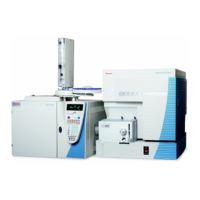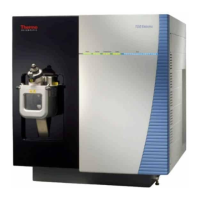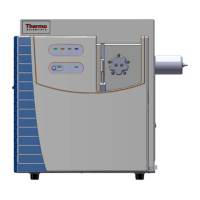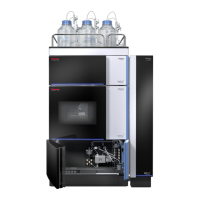7
Diagnostics and Troubleshooting
Troubleshooting
Thermo Scientific TSQ Quantum XLS Series User Guide 127
Issue: Poor sensitivity
in CI mode.
Possible causes/solutions
• An EI ion volume is installed. Install a CI ion volume as described in “Changing
Ionization Modes” on page 73.
• The small hole in the CI ion volume is plugged. Use a dental pick or old syringe needle to
clear it.
• The filament is not aligned. Remove the ion volume and check if the ion burn is centered
around the small electron entrance hole. Be sure the filament is properly inserted into the
connector. Carefully bend the filament wire to better align it with the ion volume.
• The ion volume is not inserted properly. While running the instrument, you can push on
the ion volume with the I/R tool. Be sure to monitor the pressure to ensure that you get a
good seal around the I/R tool. Otherwise, you might damage the filament. An increase in
signal calibration gas as you push on the ion volume usually indicates that the filament is
not aligned properly.
Stability Issues
Stability helps provide consistent instrument precision and the reproducibility of accurate
results. Good operating conditions for the mass spectrometer, gas chromatograph, and
autosampler contribute to instrument stability.
Sample preparation, spiking errors, sample injection errors, and lack of routine maintenance
on the instruments can cause false stability issues.
When hardware faults affect instrument stability, investigate simple solutions first, such as
cleaning the ion volume and lenses, or checking for air leaks. Usually, a hardware fault that
affects stability shows different issues than those which might be attributed to stability.
Issue: The signal
response is unstable or
drops out unexpectedly.
Possible causes/solutions
•There is a problem with the filament or lens control. See “Filament and Lens Control
Issues” on page 119 for more information.
• There is an air leak. Run the maintenance tune or the Xcalibur auto tune and calibration
procedure, which performs a leak check and returns a pass or fail message. If necessary,
check for leaks. See “High Vacuum Issues” on page 121 for more information.
• There is a high vacuum problem. See “High Vacuum Issues” on page 121 for more
information.
• There is a contamination problem. See “Contamination Issues” on page 117 for more
information.
• Dust has collected in the electron multiplier or on the conversion dynode. Contact
Thermo Fisher Scientific Technical Support.

